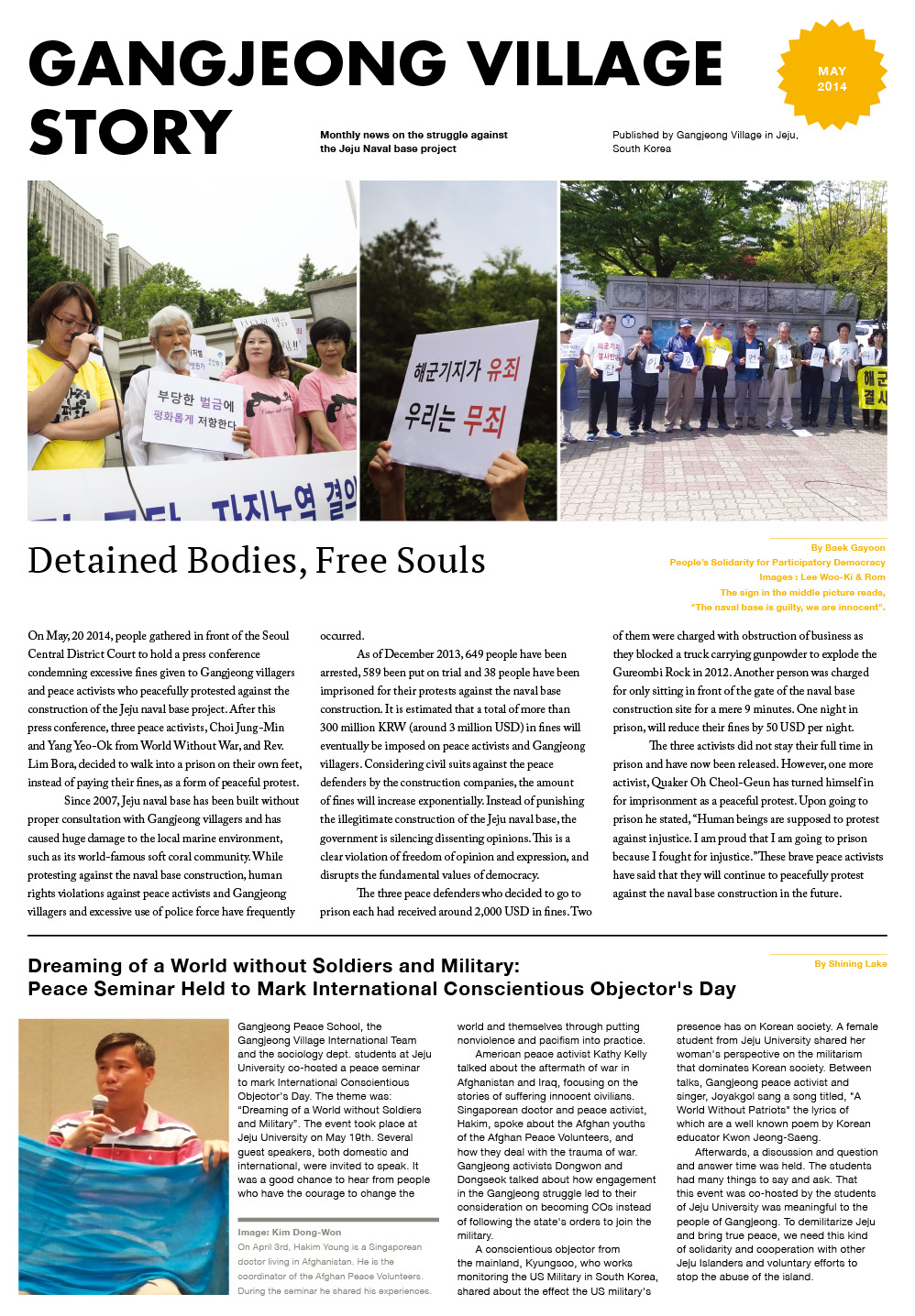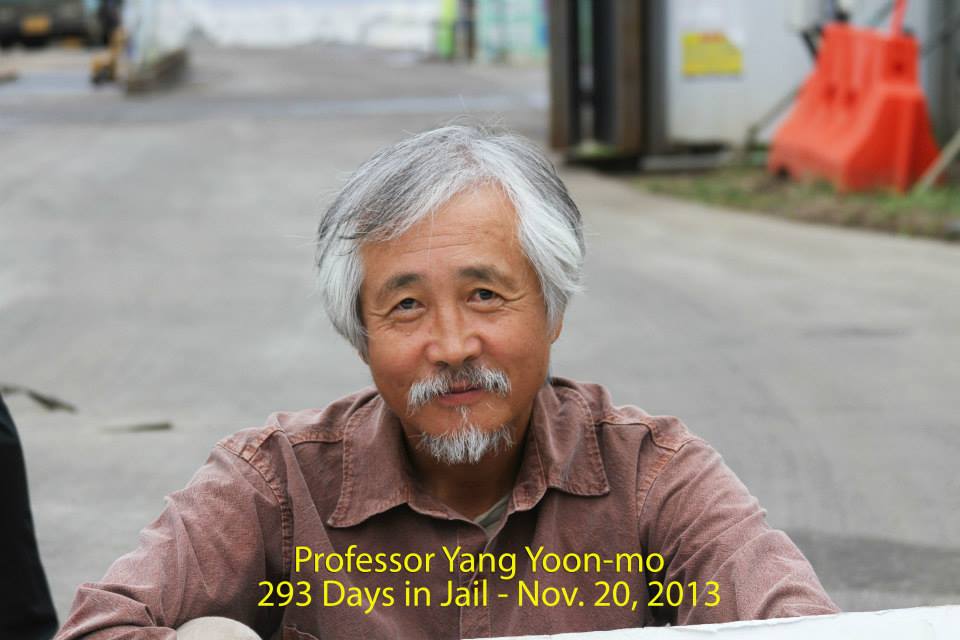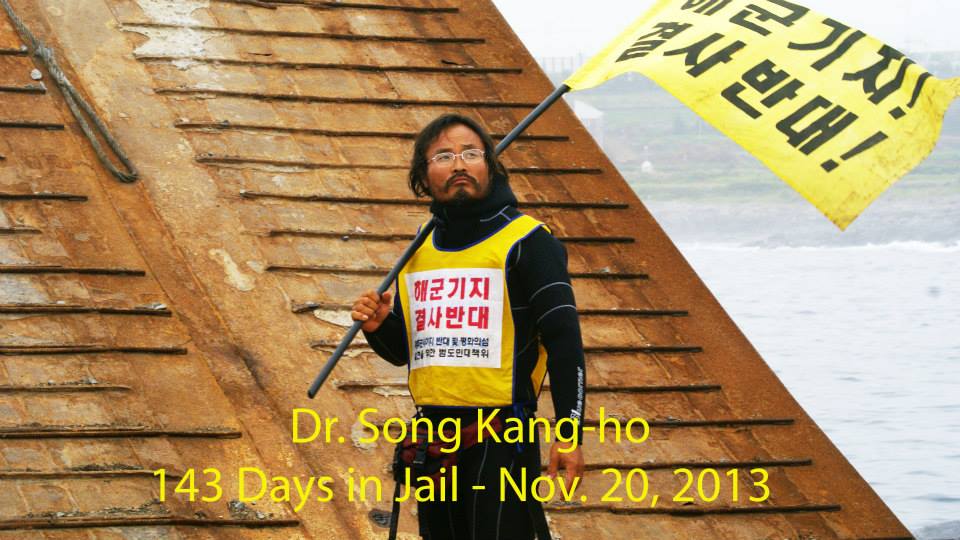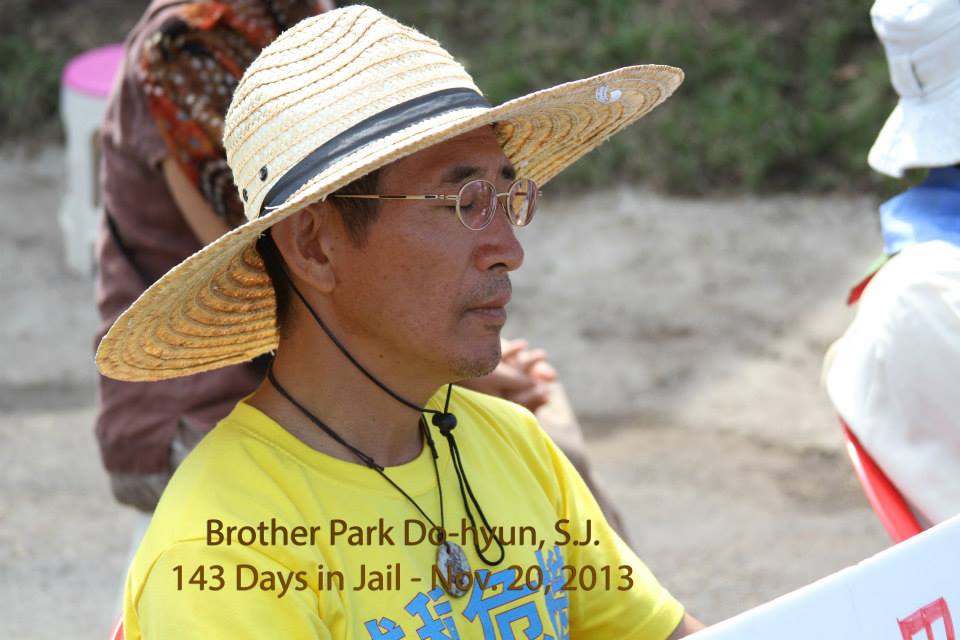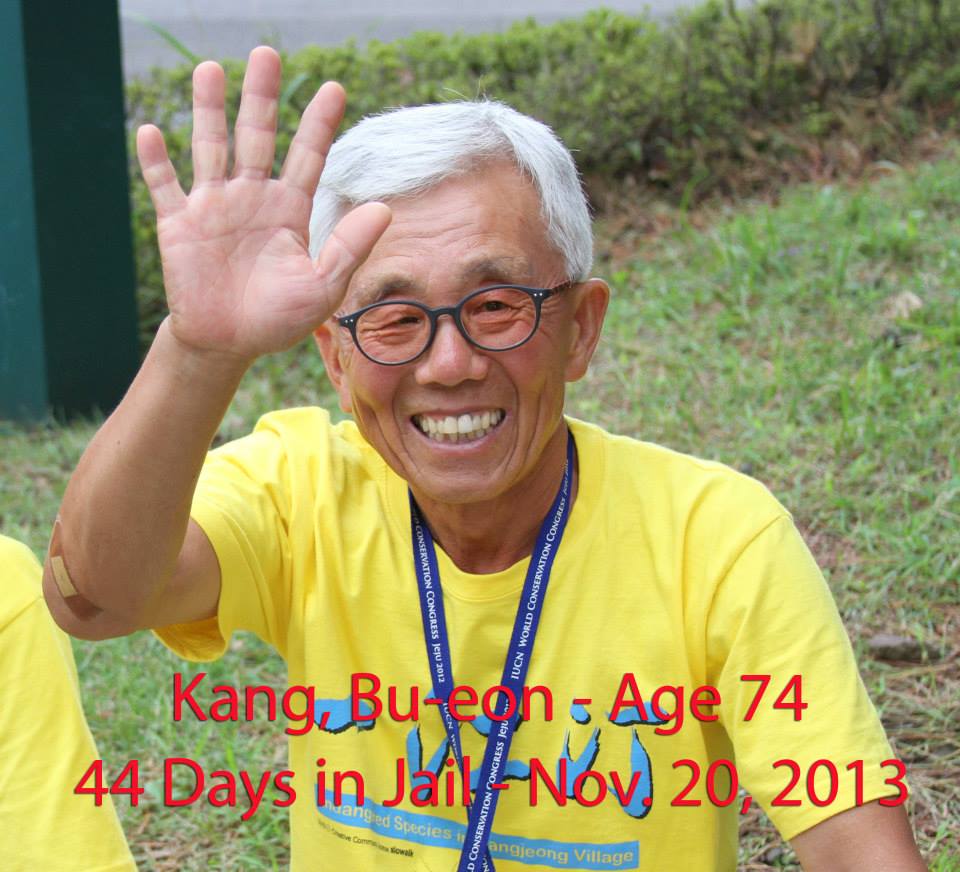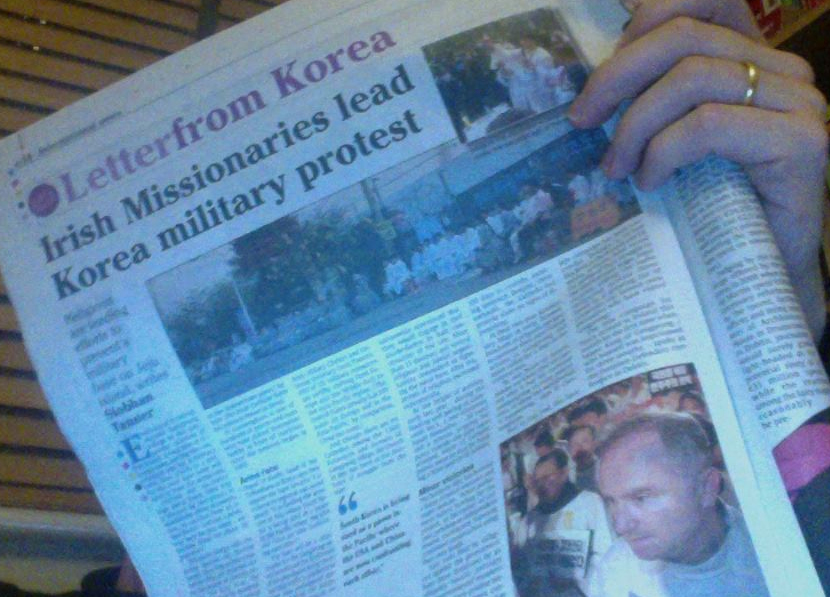In this September Edition:
Catholic Conference, anniversary of Catholic solidarity and the fence around Gureombi, International Day of Peace, remembering an Japanese anti-base activist, North East Asia Regional Peace-building Institute, hunger strikes, Okinawa updates, trial updates, international solidarity, and more!
Save Jeju Now
No War Base on the Island of Peace
Tag: civil disobedience
-
Free Gangjeong’s Five Peace Prisoners!
Update: Dr. Song Kang-Ho was released on Nov. 29. Please see here. And Mr. Kang Bu-Eon was released on Dec. 3.
Regis Tremblay, a movie director of ‘The Ghosts of Jeju,’ thankfully made these images for the English speakers. Bruce Gagnon writes in his blog:
“These good people are right now languishing inside the jail house on Jeju Island, South Korea. And there are more on the way.
Their crime? Trying to non-violently block the construction vehicles from entering the Navy base “destruction” site in Gangjeong village. In the case of Yang Yoon-Mo he got an 18 month sentence. And many people are being given severe fines to pay.
One activist from Hawaii, who spent considerable time in Gangjeong village in solidarity with the villagers, has reported: “There is no heat for male prisoners (I do not know about the women’s section of the jail) during the frigid months of winter. The conditions are inhumane.”
We can’t ever forget these good people who are fighting for peace, the environment, and human rights. See more at the official Jeju web site Save Jeju Now.‘
# Among the five, Mr. Kang Bu-Eon is a village elder, who has spent lots of time in his childhood on the Gureombi Rock. He had taken care of his sick wife who fell down for a stroke eight years ago. He himself takes four medicines for illness.
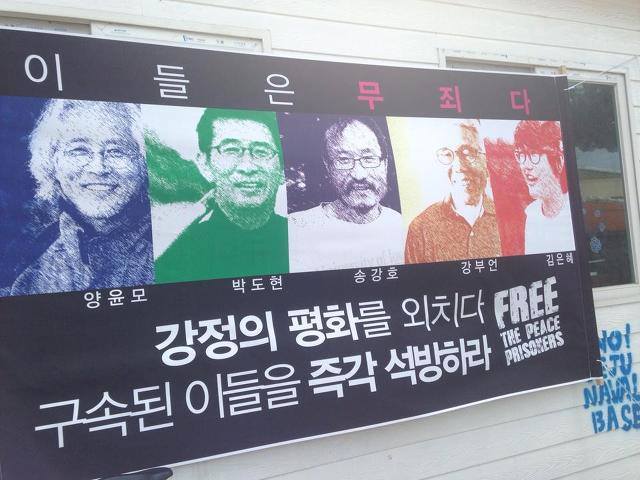
Banner image by Haku Kim/ photo by Choi Hye-Young. The banner reads, “these are no-guilty. Immediately release all the prisoners imprisoned for their crying for the peace of Gangjeong~”
-
An Irish Catholic Joining Protest Opposing Base
Re-blogged from here: The Irish Catholic, 2013. Irish Missionaries lead Korea military protest (Fwd by John Whipple). Though it does not necessarily reflect Save Jeju Now’s own view, the re-blogged article is helpful to glance on the degree of international solidarity opposing the Jeju naval base project. The role of Catholics worldwide, especially Irish Catholic’s, represented by Fr. Pat Cunningham, is remarkable.
Regarding the number of the Catholics in the village, Paco Booyah, a member of the Village International Team writes: ‘There are several villagers who are Catholics. But not many. Also because of the Catholics’ brave and strong actions, there are several villagers who have considering becoming catholic. There are more protestants than Catholics among the villagers though. And actually a majority of the villagers are Buddhist. Many villagers also believe traditional Jeju shamanism.’
Irish Missionaries lead Korea military protestReligious are leading efforts to prevent a military base on Jeju island, writes Siobhan Tanner
Religious who gathered for the anniversary Mass on Jeju.
Every day at 11 o’clock outside Gangjeong village on the spectacular coastline of Jeju island, a long line of cement trucks, serving the construction site for a military naval base, grinds to a halt. For the next hour none will enter or leave the compound.
Outside the six-metre high metal fence, their way is blocked by two priests in windblown white vestments. One, on rotation from an island parish – and one, a Jesuit, sent here for this cause – are holding Mass for about 20 protesters.
When the liturgy ends, the group spreads out, holding hands. They sing protest songs before they are drowned out by the sound of starting engines. The hour is up. The trucks, flanked by hundreds of police, army and private security (up to 600-strong, reports one observer) break forcibly and easily through the human chain, arresting some and scattering others.
This is the daily show witnessed by Colomban missionary, Fr Pat Cunningham, who has become increasingly radical since coming to South Korea in 1992.
Deportation
He has been threatened with deportation for protesting a massive military naval base on the pristine Unesco-protected island of Jeju, 50 kilometres south of the Korean peninsula. More than 130,000 police and army personnel have been sent to supress the opposition since 2011. “Surveillance is so huge down there and anyone who criticises the base is ‘red-brushed’ and labelled a North-Korean sympathiser in the mainstream press,” he tells The Irish Catholic from his mission house in Seoul.
Fr Cunningham is one of hundreds of priests and nuns who have placed themselves bodily in front of machines since the protests began in 2007.
Arms race
Donal O’ Keefe, head of the Colombans in Korea says they oppose the base because it is a threat to regional and world peace. “It is fuelling the arms race in Asia where South Korea is being used as a pawn in the Pacific where the USA and China are now confronting each other.”
The base will be a catastrophe for the Gangjeong environment and the livelihoods of the population living there; warship traffic is predicted to drive nine endangered species, including the bottle-nosed dolphin, towards extinction.
Due to be finished by primary contractors Samsung in 2014, the base will be contracted by the US to house 7,000 marines and 20 warships, including aircraft carriers, nuclear submarines and destroyers armed with ballistic missiles which will patrol the East China Sea.
Koohan Paik, campaign director of a forum on Globalisation’s Asia-Pacific programme says Jeju is just one island in a growing constellation of geostrategic points that are being militarised as part of President Obama’s ‘Pacific Pivot’, a major initiative announced late in 2011 to counter a rising China. According to separate statements by then Secretary of State Hillary Clinton and Defense Secretary Leon Panetta, 60% of US military resources are swiftly shifting from Europe and the Middle East to the Asia-Pacific region. (The United States already has 219 bases on foreign soil in the Asia-Pacific; by comparison, China has none.)
And though there are no Catholics among the 1,500 fishermen and farmers of Gangjeong village, the Church in Jeju has been at the forefront of struggle from the start.
Hunger strike
When the governor of Jeju (since ousted) agreed to accept the naval base on the island province in 2007, local priests went on a hunger strike and their bishop, Peter Kang U-il, wrote an open letter to South Korea’s president urging a referendum on the plan.
The Jesuits too waded into the battle early, sending priests from the mainland – four of whom were imprisoned for sentences ranging from one month to three.
Then, two years ago, the Church in Korea made a bold political move when clergy nationwide announced that they would engage in civil disobedience to halt construction of the site. More than 15 dioceses and several religious and justice organisations committed to fighting the naval base. After this, arrests of religious increased exponentially.
At the height of activity early last year – during the blasting and paving of Gureombi Rock, a one-kilometre basalt formation – 20 nuns and a priests, praying for peace outside the gate were arrested, while 13 Catholic priests went on trial for holding a Mass and sit-in protest.
Minor victories
The battle for Jeju has become a litany of minor victories and major defeats. When parliament halted funding for the project, in December of last year, pending an independent review, contractors Samsung continued construction using their own funds.
Law suits filed by villagers against the government have been dismissed by an allegedly hostile judiciary and environmental monitors report that once-pristine water sources have been contaminated while dredging has started to kill the underwater coral.
Meanwhile, the penal crackdown on activists has increased.
Three months ago, Brother Park Do-Hyun and Dr Sang Kang-Ho, members of Save Our Seas, were arrested while monitoring the dredging of the sea-bed which was being done without environmental protection measures.
Both men have passed 100 days in custody, awaiting sentence. Despite, these setbacks, the Catholic-led protests show no signs of diminishing.
At their two-year anniversary Mass in early October, hundreds of religious pledged to continue their non-violent actions in Gangjeong and again called for a stop to the construction.
“In our heart of hearts, maybe we know that we cannot stop it but we continue campaigning to raise awareness, to show the world what is happening,” says Fr Cunningham.
And to this end, the Save Jeju campaign has been successful. Despite a virtual blackout in the Korean and US media, activists have raised the profile of their struggle to the international stage, most recently adding the name Hollywood director Oliver Stone to a growing list of celebrities and famous commentators who have visited Gangjeong.
The Jeju campaign for Peace arrived in Ireland this month for the first time when Mayor Kang of Gangjeong – who himself was imprisoned for three months – spoke at the Frontline Defenders conference in Dublin.
– See more at: http://www.irishcatholic.ie/article/irish-missionaries-lead-korea-military-protest#sthash.Osd7LLh3.dpuf
…………………………………..
-
Fr. Bix and Monk Gilberto on Jeju Island!
See also
Video: FR. William “BIX” Bichsel, S.J. On His Jeju Trip
Video: Fr. Bix interviews Bishop Kang
……………………………….

Source: PAX Christi USA, Oct. 31, 2013 Re-blogged from the blog of Disarm Now Plowshares, Oct. 1, 2013
(‘This is from an email written by Br. Gilberto Perez, a Nipponzan Myohoji Buddhist monk from Bainbridge Island, Washington, who accompanied Fr. Bix Bichsel to Jeju in September of this year. More writings from Bix and Gilberto in the attached link.’ By Leonard Eiger on Oct. 25, 2013)
Bix and Gilberto on Jeju Island!
Dear Friends,
In March 2012, at our yearly gathering of the Pacific Life Community, Dennis Apel of the Guadalupe Catholic Worker first introduced to PLC that US naval ships/subs were soon to be stationed on Jeju Island.
True to form of all actions and involvements the US is into and doesn’t want the American people to know about, don’t look for too much information about JeJu in the US press. These next two web sites can provide a lot of information most folks have no clue about.
You can see the photo’s Dennis took of his trip to Jeju on http://vpan.org/resources/Jeju-Island-of-Peace
Bix has been very focused on wanting to respond to the call of the religious and lay community on Jeju. Daily vigils and resistance actions have been in place for quite some time with the hope that one day the construction will end and this very dangerous American Funded Naval base 300 miles from mainland China will cease to be.
On September 23rd Bix, and Gilberto Perez flew from Seattle to Seoul Korea. They spent one day in Seoul and then directly onto Jeju. They have joined in with the resistance community on Jeju and the following reports give a lively report of his and Gilberto’s activities.
They are due back here in Seattle on the 8th of October. In the meantime the following are some thoughts from Bix and Gilberto.
****************************
Van-den-berg vigil September 26, 2013 From Bix
You would see and feel the holiness of this island; after returning from the regular daily practice of 100 bows (stand-kneel-deep bow) in front of a main gate of the construction site–with a view of the great sea beyond the site. The woman who started this deep bowing practice two years ago was there and today she was assisted by Gilberto and I, two Korean Notre Dame Sisters, a young woman from the US and two Korean women from Jeju. One of the ND Sisters said to me, “Your country has done this to us”!
Very much wish Steve Kelly and Louie Vitale would have been able to make this trip. Their life experience, and ability to absorb and appreciate another culture would be solidarity plus. We have been greatly welcomed by all Jesuits and well provided for and well scheduled.Fr. Kim,S.J. lives on Jeju Island in a small house rented by the Jesuit Order. He lives in community with two other Jesuits; one, Brother Pamk, is in jail for resistance to the naval base; the other, Fr. Lee is presently on trial for resistance activities. Fr. Kim has been jailed on different occasions for resistance. Jeju resistance and village -building is his assigned apostolate.
We began this day with Eucharist being celebrated at the gate leading into the construction site. We were four priests, five nuns, and four village women. The village men sat in chairs in front other main gate.
The police showed up in droves (high employment). When the time came for the construction trucks to enter the building site, the police surrounded us, asked us to leave, then carried all of us in our chairs to the sideline. Best chair- sedan ride ever. This happened four times. No arrests. Eucharist was being prayed and sung all the while. We all received communion.
September 27, 2013
We are living in Gangjeong Village here on Jeju Island and the village life is wonderful. Daily Eucharist and rosary is ended with high spirited Korean dance and song. We then have lunch in the community meal long-home. Fr. Kim had arranged for Gilberto and me to attend the ongoing investigative trials of Brother Park, S.J. (who lives in community with Fr. Kim) and Doctor Song who were being held in jail for their resistance work against the naval base.
Signs of community solidarity are clear to see; however, there is division also with some of the islanders. After the court visit Fr. Kim drove us to the hospital to visit a village woman resister who was struck many times by a villager who disagreed with the resistance. Though most of the people of Jeju Island and South Korea don’t want the base, there are those that support it.
This division was made manifest when the coordinator of the community meal hut was brought into the emergency room with multiple facial injuries while we were at the hospital. He had made a remark to a villager opposed to the resistance and the villager struck him in the face many times. Many members of the resistance community showed up and were very vocal in their opposition to the police, who were investigating the victim rather than the perpetrator. Sometime after midnight we left the hospital with Fr. Kim who drove us to our guest house.
 After the 100 bows, Eucharist and rosary, dancing and singing, and lunch in the community meal hut, we traveled to Jeju City to visit Brother Park, S.J. in jail. His spirit is strong and he is very alive and committed to his justice work.
After the 100 bows, Eucharist and rosary, dancing and singing, and lunch in the community meal hut, we traveled to Jeju City to visit Brother Park, S.J. in jail. His spirit is strong and he is very alive and committed to his justice work.I’m experiencing this time as a real retreat. The oneness of the Eucharist unifying all people in a live background stirs me. The signs of resistance and the dancing and singing give life and vibrancy to the Eucharist. What I’m experiencing is a church alive with a bishop calling for resistance.
September 29, 2013
Great conversations today with two Korean Jesuit Priest, each named Kim. This is the most alive and vibrant faith community I’ve ever experienced. Daily Eucharist is the foundation of the ongoing acts of resistance which also occur each day. Everyday priests, nuns and villagers sit in chairs blocking the main gate while the sung Eucharist up the road is being broadcast. After the Mass and rosary there is very vibrant Korean dance that knocks your socks off and fills you with joy. After this there is lively song. This is followed by Korean lunch—kim chi style- that is held
in the community meal house that has free and open meals every day. The atmosphere is light and alive with communication. At 7AM the day starts with a village lady who leads us in 100 deep down on your knees bows in front of the gate. Different blocking actions take place in the afternoon. Each order of nuns sends two nuns every week to vigil and resist. They stay in a guest house that is rented by the diocese. Four Jesuits are assigned to full time resistance work. The bishop is fabulous and calls villagers to resistance as well as assigning priests to work for peace.
At 4pm the bishop of Jeju will lead the Eucharist gathering in front of the main gate where Gilberto and I with other priests and nuns will block the gate. It is not yet clear to us but we are talking about an action on St.Francis day to call Pope Francis to join the opposition and resistance to the naval base at Jeju Island. However, today the regular resistance community expects hundreds to show up. Gilberto and I will be blocking all day.
More later—love Bix
*******************************
From: Gilbeto Perez September 29, 2013
Na Mu Myo Ho Ren Ge Kyo,
We bow hundred times in front of naval construction site with nuns and Fr. Bix. Very tough nuns, just like Sr. Junsan. Oliver Stone was here about a month ago and also prayed and bowed at local sacred location where US and Korea police massacred over 30,000 left wing peoples, mostly farmers and whole families, burned villages just like Vietnam..began 1946 ended in 1948. US called Jeju a “Red” island during this period. After freedom from Japanese, Koreans did not want another colonizer, therefore the arguments and massacre.

We all continue to pray. Yesterday and today over 75 Catholic nuns, 45 Jesuits and even the Bishop performed Sunday Mass. With over 300 local peoples and big dinner party at the village center. Reminds me of Cuba and Mexico where everyone in town is invited. Many of the nuns, priests and Bishop came from Seoul.Yes, Koreans are very passionate about peace and prayers, many studied in Berkeley, Boston and even the Philippines too. Two young Americans are here but not able to block gate, as they want to return to Korea. We sit in front of gate while Mass is said and police carry us off to let trucks and cars on/off the base and then we just return again. Police are thus far been pretty gentle. They remove us and lots of filming while this is performed, about five time each day.
Fr. Bix becomes like a young teenager when he is resisting the empire and very funny and happy with all…A baby Buddha.
Being near ocean means fresh fish and wonderful vegetables, cheese…No cows! Yes, US has taken the most beautiful location for the naval nuclear site, with approval of government (Eminent Domain) and destroyed the coral reed too.
So much to say about the Koreans, very respectful to elders and all participate in actions with joy and dancing after mass…I like the dancing in front of the gate the best.
Gassho, love to all and much peace, – Br. Gilberto
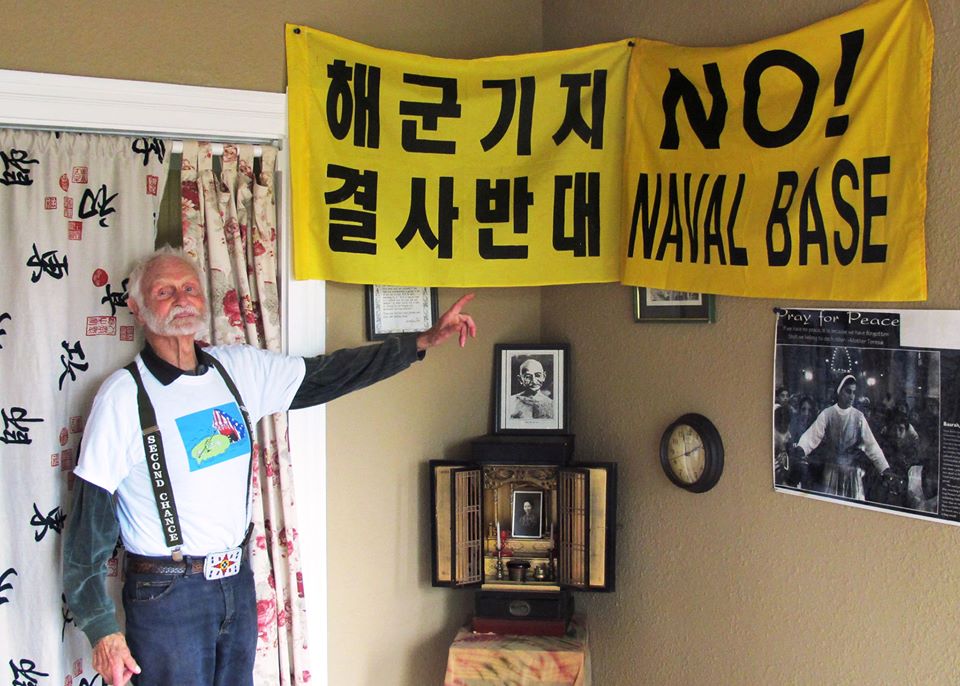
Photo by Leonard Eiger on Nov. 3/ “With Fr. Bichsel yesterday. Along with Br. Fred Mercy, we discussed and made plans to increase support here in Washington State for the people’s struggle for Jeju. Lots of good ideas! Now, to get more people here aware, educated and engaged in our common struggle.”



